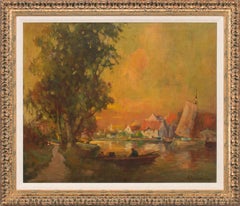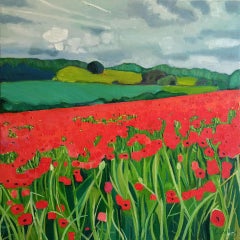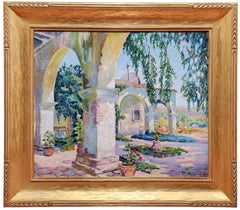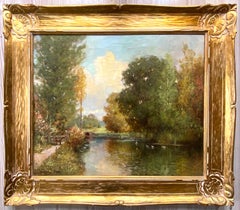George Thompson Pritchard Paintings
George Thompson Pritchard, a painter from New Zealand, was best known for his landscapes, riverscapes and seascapes. He was married in London on September 25, 1915, to Valerie Lucy, with whom he had four children, Paul, Valerie, Gabrielle and Vashti. Born in Havelock, New Zealand in 1878 to Alfred and Emily Pritchard, the artist spent much of his young life studying his craft. He began studies at the Academy of Art in Auckland, followed closely by the Elam School of Art and eventually the Melbourne Academy of Fine Arts. While studying in Australia, he worked for newspapers and eventually became the political editor of the Sydney Morning Herald. In 1901, Pritchard traveled to Paris for further study at the Académie Julian. Gifted both as a musician and artist, Pritchard wanted to be a violinist in his early years, but the loss of his left forearm ended any thought of a career in music. As a result, he focused his full attention on being an artist and in particular, a painter. In 1906, he immigrated to the US, arriving in San Francisco, a city still full of smoking ruins from the disastrous earthquake and fire. He remained there for almost three years and produced many works of art before relocating to Milwaukee. There, he established an art school, which he continued to run until he left to continue his studies at the Vanderveldt Academy in Amsterdam from 1911–14. Never one to stay settled for long, Pritchard relocated to England just before the outbreak of World War I, where he completed his studies under Sir Alfred East, a member of the Royal Academy. To earn pocket money, he designed and built boats for Māori. For a time, he also temporarily abandoned his art career to work as a production manager of a munitions factory. Over the next several years during the war, Pritchard continued his travels, living in Canada, New York City and Richmond, Virginia. While living in Richmond from 1925–31, he lectured and exhibited at universities and colleges in the South. Those exhibits were highly successful and many of his paintings were purchased during that time. Eventually, in 1935, he settled in Southern California, where he founded studios in Glendale and Santa Monica, exhibiting regularly with the Glendale and Santa Monica Art Associations. He continued to teach in his studios until his retirement in 1946. He subsequently devoted all of his time to painting and writing for his pleasure, never offering any of his works for sale again. One of his paintings created during his retirement, Signing of the Bill of Rights was donated to the New Zealand House of Parliament. Shortly before his death, he completed a book on world economics entitled Whom the Gods Destroy. He was a member of the Masonic Order, the Glendale and Santa Monica Art Associations and numerous art and literary organizations in New Zealand, Australia, Holland and the USA. George Thompson Pritchard died in 1962, a few weeks before his 84th birthday.
1930s Impressionist George Thompson Pritchard Paintings
Oil, Canvas
Early 20th Century George Thompson Pritchard Paintings
Canvas, Oil
21st Century and Contemporary Impressionist George Thompson Pritchard Paintings
Canvas, Oil
Early 20th Century American Impressionist George Thompson Pritchard Paintings
Canvas, Oil
Mid-20th Century Impressionist George Thompson Pritchard Paintings
Oil, Canvas
21st Century and Contemporary Impressionist George Thompson Pritchard Paintings
Canvas, Oil
21st Century and Contemporary Impressionist George Thompson Pritchard Paintings
Canvas, Oil
1960s Modern George Thompson Pritchard Paintings
Canvas, Oil
20th Century American Impressionist George Thompson Pritchard Paintings
Canvas, Oil
Early 18th Century Italian School George Thompson Pritchard Paintings
Canvas, Oil
2010s Impressionist George Thompson Pritchard Paintings
Canvas, Oil
Early 20th Century Impressionist George Thompson Pritchard Paintings
Canvas, Oil
2010s Impressionist George Thompson Pritchard Paintings
Canvas, Lacquer, Oil
Mid-20th Century Modern George Thompson Pritchard Paintings
Oil, Canvas
1930s Post-Impressionist George Thompson Pritchard Paintings
Canvas, Oil




